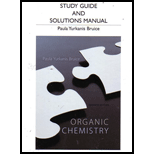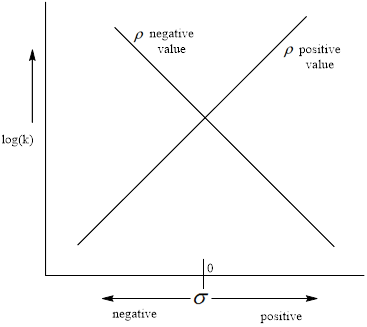
(a)
Interpretation:
To explain the following result obtain from theHammett equation.
Concept introduction:
Hammett reaction constant (

The negative value of the
(b)
Interpretation:
To explain the following result obtain from theHammett equation.
Concept introduction:
Hammett reaction constant (

The negative value of the
(c)
Interpretation:
To explain the following result obtain from theHammett equation.
Concept introduction: Hammett reaction constant (

The negative value of the
Trending nowThis is a popular solution!

Chapter 16 Solutions
Organic Chemistry
- Following is a balanced equation for bromination of toluene. (a) Using the values for bond dissociation enthalpies given in Appendix 3, calculate H0 for this reaction. (b) Propose a pair of chain propagation steps and show that they add up to the observed reaction. (c) Calculate H0 for each chain propagation step. (d) Which propagation step is rate-determining?arrow_forwardUemura and coworkers studied a time dependent Diels-Alder reaction which first formed the endo product as the major organic product and with time produced the exo product (J. Org. Chem. 2018, 83, 9300−9304). Show the endo and exo product for the reaction below. Which is the thermodynamic product and which is the kinetic product? Explain your reasoning.arrow_forwardWhich is more stable - a phenyl radical, [C6H5]•, or a benzyl radical, [C6H5CH2]• - and why?arrow_forward
- On acid-catalyzed dehydration, 1-butanol (CH3CH2CH2CH2OH) can be converted to 1-butene. Write out an equation for the reaction Assign each the appropriate symbol for the mechanism of the reaction (E1 or E2) Draw a suitable mechanism for the reactionarrow_forwardWhen (1-bromoethyl)cyclohexane is heated in methanol for an extended period of time, five products result: two ethers and three alkenes. Predict the products of this reaction, and propose mechanisms for their formation. Predict which of the three alkenes is the major elimination productarrow_forwardThis problem is adapted from an experiment designed for undergraduate organic chemistry laboratories. (a) Reaction of (E)-1-(p-methoxyphenyl)propene with m-chloroperoxybenzoic acid converted the alkene to its corresponding epoxide. Give the structure, including stereochemistry, of this epoxide.(b) Assign the signals in the 1H NMR spectrum of the epoxide to the appropriate hydrogens. δ 1.4 (doublet, 3H) δ 3.8 (singlet, 3H) δ 3.0 (quartet of doublets, 1H) δ 6.9 (doublet, 2H) δ 3.5 (doublet, 1H) δ 7.2 (doublet, 2H) (c) Three signals appear in the range δ 55–60 in the 13C NMR spectrum of the epoxide. To which carbons of the epoxide do these signals correspond? (d) The epoxide is isolated only when the reaction is carried out under conditions (added Na2CO3) that ensure that the reaction mixture does not become acidic. Unless this precaution is taken, the isolated product has the molecular formula C17H17O4Cl. Suggest a reasonable structure for this product and write a reasonable mechanism…arrow_forward
- Using your knowledge of general chemistry and organic chemistry, answer the following questions: Predict the relative acidities within each of the following groups, then identify the conjugate bases, and finally predict their relative leaving group abilities HClO3 and HClO2 PH3 and H2S [NH4]+ and [H3O]+ Explain why the trifluoromethane sulfonate (TfO-) ion is a better leaving group than the methanesulfonate (MsO-) ion.arrow_forwarda. Compound X is benzene, Y is acetic anhydride acid. Complete the following scheme and determine Z! b. Determine which reagents except acetic acid anhydrides can replace Y!arrow_forwardStrong support for the mechanism of the nucleophilic aromatic substitutionreaction that proceeds through a benzyne intermediate comes from the reaction shown here, in which bromobenzene is treated with KNH2 in the presence of cyclopentadiene. A product that is isolated has the formula C11H10. Draw the structure of that product and explain how it validates the production of a benzyne intermediate.arrow_forward
- when furan and maleimide undergo a diels alder reaction at 25 celcius the major product is the endo adduct when the reaction is carried out at 90 celcius the major product is exo isomer the endo adduct isomerizes to the exo adduct when it is heated to 90 celcius. propose explanation that will account for these results and what is the mechanism of this reactionarrow_forwardWrite a radical mechanism monobromination for the following compounds: a. Cyclopentane to form bromocyclopentane b. butane to form 2-bromobutane c. methylcyclopentane to form 1-bromo-1-methylcyclopentanearrow_forwardThe C‚N triple bond in acetonitrile has a dipole moment of about 3.6 D and a bond length of about 1.16 Å. Calculate the amount of charge separation in this bond. How important is the charge-separated resonance form in the structure of acetonitrile?arrow_forward
 Organic ChemistryChemistryISBN:9781305580350Author:William H. Brown, Brent L. Iverson, Eric Anslyn, Christopher S. FootePublisher:Cengage Learning
Organic ChemistryChemistryISBN:9781305580350Author:William H. Brown, Brent L. Iverson, Eric Anslyn, Christopher S. FootePublisher:Cengage Learning Organic Chemistry: A Guided InquiryChemistryISBN:9780618974122Author:Andrei StraumanisPublisher:Cengage Learning
Organic Chemistry: A Guided InquiryChemistryISBN:9780618974122Author:Andrei StraumanisPublisher:Cengage Learning


